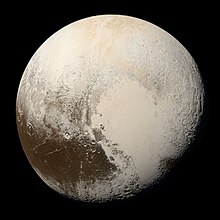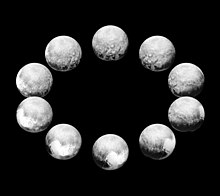પ્લૂટો
Appearance
 પ્લુટોનો ઉત્તર ગોળાર્ધ[lower-alpha ૧] | |||||||||
| Discovery | |||||||||
|---|---|---|---|---|---|---|---|---|---|
| Discovered by | Clyde W. Tombaugh | ||||||||
| Discovery site | Lowell Observatory | ||||||||
| Discovery date | February 18, 1930 | ||||||||
| Designations | |||||||||
Designation | (134340) Pluto | ||||||||
| Pronunciation | /ˈpluːtoʊ/ ( | ||||||||
Named after | Pluto | ||||||||
| Adjectives | Plutonian /pluːˈtoʊniən/[૧] | ||||||||
| Orbital characteristics[૪][lower-alpha ૨] | |||||||||
| Epoch J2000 | |||||||||
| Earliest precovery date | August 20, 1909 | ||||||||
| Aphelion |
| ||||||||
| Perihelion | |||||||||
| |||||||||
| Eccentricity | 0.2488 | ||||||||
| 366.73 days[૨] | |||||||||
Average orbital speed | 4.743 km/s[૨] | ||||||||
| 14.53 deg | |||||||||
| Inclination |
| ||||||||
| 110.299° | |||||||||
| 113.834° | |||||||||
| Known satellites | 5 | ||||||||
| Physical characteristics | |||||||||
| Dimensions | 2,376.6±1.6 km (observations consistent with a sphere, predicted deviations too small to be observed)[૫] | ||||||||
Mean radius | |||||||||
| Flattening | <1%[૭] | ||||||||
| |||||||||
| Volume |
| ||||||||
| Mass | |||||||||
Mean density | 1.854±0.006 g/cm3[૬][૭] | ||||||||
| |||||||||
| 1.212 km/s[lower-alpha ૬] | |||||||||
| |||||||||
Equatorial rotation velocity | 47.18 km/h | ||||||||
| 122.53° (to orbit)[૨] | |||||||||
North pole right ascension | 132.993°[૮] | ||||||||
North pole declination | −6.163°[૮] | ||||||||
| Albedo | 0.49 to 0.66 (geometric, varies by 35%)[૨][૯] | ||||||||
| |||||||||
| 13.65[૨] to 16.3[૧૦] (mean is 15.1)[૨] | |||||||||
| −0.7[૧૧] | |||||||||
| 0.06″ to 0.11″[૨][lower-alpha ૭] | |||||||||
| Atmosphere | |||||||||
Surface pressure | 1.0 Pa (2015)[૭][૧૩] | ||||||||
| Composition by volume | Nitrogen, methane, carbon monoxide[૧૨] | ||||||||

પ્લૂટો (પ્રતીક: ![]() [૧૪] અને
[૧૪] અને ![]() [૧૫]) પહેલાં સૂર્યમંડળના નવમા ગ્રહ તરીકે ઓળખવામાં આવતો હતો, પણ હવે તેને સૌરમંડળના બીજા સૌથી મોટા વામન ગ્રહ તરીકે વર્ગીકૃત કરવામાં આવે છે. તેની સૂર્યની આસપાસ પરીભ્રમણ કક્ષા એટલી લંબગોળ છે જેને કારણે તે નૅપ્ચ્યુન ગ્રહની કક્ષા ની અંદર પ્રવેશ કરે છે. પ્લૂટો સૂર્યથી ખૂબ દૂર હોવાને કારણે તે આખો બરફથી ઢંકાયેલો છે અને અંધાર્યો છે.
[૧૫]) પહેલાં સૂર્યમંડળના નવમા ગ્રહ તરીકે ઓળખવામાં આવતો હતો, પણ હવે તેને સૌરમંડળના બીજા સૌથી મોટા વામન ગ્રહ તરીકે વર્ગીકૃત કરવામાં આવે છે. તેની સૂર્યની આસપાસ પરીભ્રમણ કક્ષા એટલી લંબગોળ છે જેને કારણે તે નૅપ્ચ્યુન ગ્રહની કક્ષા ની અંદર પ્રવેશ કરે છે. પ્લૂટો સૂર્યથી ખૂબ દૂર હોવાને કારણે તે આખો બરફથી ઢંકાયેલો છે અને અંધાર્યો છે.
પ્લૂટો પૃથ્વીના ઉપગ્રહ ચંદ્રથી પણ નાનો છે. પ્લૂટોને ૫ ચંદ્ર છે. પ્લૂટોનું તાપમાન -૨૩૩° સે. સુધીનું હોય છે.
નોંધ
[ફેરફાર કરો]- ↑ This photograph was taken by the Ralph telescope aboard New Horizons on July 14, 2015 from a distance of 35,445 km (22,025 mi). The most prominent feature in the image, the bright, youthful plains of Tombaugh Regio and Sputnik Planitia, can be seen at right. It contrasts the darker, more cratered terrain of Cthulhu Macula at lower left. Because of Pluto's 119.591° tilt at its axis, the southern hemisphere is barely visible in this image; the equator runs through Cthulhu Macula and the southern parts of Sputnik Planitia.
- ↑ The mean elements here are from the Theory of the Outer Planets (TOP2013) solution by the Institut de mécanique céleste et de calcul des éphémérides (IMCCE). They refer to the standard equinox J2000, the barycenter of the Solar System, and the epoch J2000.
- ↑ Surface area derived from the radius r: .
- ↑ Volume v derived from the radius r: .
- ↑ Surface gravity derived from the mass M, the gravitational constant G and the radius r: .
- ↑ Escape velocity derived from the mass M, the gravitational constant G and the radius r: .
- ↑ Based on geometry of minimum and maximum distance from Earth and Pluto radius in the factsheet
સંદર્ભો
[ફેરફાર કરો]- ↑ Plutonian (3rd ed.), Oxford University Press, September 2005, http://oed.com/search?searchType=dictionary&q=Plutonian ઢાંચો:OEDsub
- ↑ ૨.૦૦ ૨.૦૧ ૨.૦૨ ૨.૦૩ ૨.૦૪ ૨.૦૫ ૨.૦૬ ૨.૦૭ ૨.૦૮ ૨.૦૯ Williams, David R. (July 24, 2015). "Pluto Fact Sheet". NASA. મેળવેલ August 6, 2015.
- ↑ "Horizon Online Ephemeris System for Pluto Barycenter". JPL Horizons On-Line Ephemeris System @ Solar System Dynamics Group. મેળવેલ January 16, 2011. (Observer Location @sun with the observer at the center of the Sun)
- ↑ Simon, J.L.; Francou, G.; Fienga, A.; Manche, H. (September 2013). "New analytical planetary theories VSOP2013 and TOP2013". Astronomy and Astrophysics. 557 (2): A49. Bibcode:2013A&A...557A..49S. doi:10.1051/0004-6361/201321843. The elements in the clearer and usual format is in the spreadsheet and the original TOP2013 elements here.
- ↑ ૫.૦ ૫.૧ Nimmo, Francis (2017). "Mean radius and shape of Pluto and Charon from New Horizons images". Icarus. 287: 12–29. arXiv:1603.00821. Bibcode:2017Icar..287...12N. doi:10.1016/j.icarus.2016.06.027. Unknown parameter
|displayauthors=ignored (|display-authors=suggested) (મદદ) - ↑ ૬.૦ ૬.૧ Stern, S. A.; Grundy, W.; McKinnon, W. B.; Weaver, H. A.; Young, L. A. (2017). "The Pluto System After New Horizons". Annual Review of Astronomy and Astrophysics. 2018: 357–392. arXiv:1712.05669. doi:10.1146/annurev-astro-081817-051935.
- ↑ ૭.૦ ૭.૧ ૭.૨ ૭.૩ Stern, S. A. (2015). "The Pluto system: Initial results from its exploration by New Horizons". Science. 350 (6258): 249–352. arXiv:1510.07704. Bibcode:2015Sci...350.1815S. doi:10.1126/science.aad1815. PMID 26472913. Unknown parameter
|displayauthors=ignored (|display-authors=suggested) (મદદ) - ↑ ૮.૦ ૮.૧ Archinal, Brent A.; A'Hearn, Michael F.; Bowell, Edward G.; Conrad, Albert R.; Consolmagno, Guy J.; et al. (2010). "Report of the IAU Working Group on Cartographic Coordinates and Rotational Elements: 2009" (PDF). Celestial Mechanics and Dynamical Astronomy. 109 (2): 101–135. Bibcode:2011CeMDA.109..101A. doi:10.1007/s10569-010-9320-4. મૂળ (PDF) માંથી માર્ચ 4, 2016 પર સંગ્રહિત. મેળવેલ સપ્ટેમ્બર 26, 2018.
- ↑ Hamilton, Calvin J. (February 12, 2006). "Dwarf Planet Pluto". Views of the Solar System. મેળવેલ January 10, 2007.
- ↑ "AstDys (134340) Pluto Ephemerides". Department of Mathematics, University of Pisa, Italy. મેળવેલ June 27, 2010.
- ↑ "JPL Small-Body Database Browser: 134340 Pluto". મેળવેલ June 12, 2008.
- ↑ "Pluto has carbon monoxide in its atmosphere". Physorg.com. April 19, 2011. મેળવેલ November 22, 2011.
- ↑ Amos, Jonathan (July 23, 2015). "New Horizons: Pluto may have 'nitrogen glaciers'". BBC News. મેળવેલ July 26, 2015.
It could tell from the passage of sunlight and radiowaves through the Plutonian "air" that the pressure was only about 10 microbars at the surface
- ↑ JPL/NASA (2015-04-22). "What is a Dwarf Planet?". Jet Propulsion Laboratory. મેળવેલ 2022-01-19.
- ↑ John Lewis, સંપાદક (2004). Physics and chemistry of the solar system (2 આવૃત્તિ). Elsevier. પૃષ્ઠ 64.
પૂરક વાચન
[ફેરફાર કરો]- Codex Regius (2016), Pluto & Charon, CreateSpace Independent Publishing Platform ISBN 978-1534960749
- Stern, S A and Tholen, D J (1997), Pluto and Charon, University of Arizona Press ISBN 978-0816518401
- Stern, Alan; Grinspoon, David (2018). Chasing New Horizons: Inside the Epic First Mission to Pluto. Picador. ISBN 978-125009896-2.
બાહ્ય કડીઓ
[ફેરફાર કરો]| Pluto વિષય પર વધુ જાણવા માટે જુઓ: | |
|---|---|
| શબ્દકોશ | |
| પુસ્તકો | |
| અવતરણો | |
| વિકિસ્રોત | |
| દ્રશ્ય-શ્રાવ્ય માધ્યમો અને ચિત્રો | |
| સમાચાર | |
| અભ્યાસ સામગ્રી | |
- New Horizons homepage સંગ્રહિત ૨૦૧૫-૦૭-૨૬ ના રોજ વેબેક મશિન
- Pluto Profileat NASA's Solar System Exploration site
- NASA Pluto factsheet
- Website of the observatory that discovered Pluto
- Earth telescope image of Pluto system સંગ્રહિત ૨૦૧૨-૧૧-૦૫ ના રોજ વેબેક મશિન
- Keck infrared with AO of Pluto system
- Gray, Meghan (2009). "Pluto". Sixty Symbols. Brady Haran for the University of Nottingham.
- Video – Pluto – viewed through the years (GIF) (NASA; animation; July 15, 2015).
- Video – Pluto – "FlyThrough" (00:22; MP4) (YouTube) (NASA; animation; August 31, 2015).
- "A Day on Pluto Video made from July 2015 New Horizon Images" Scientific American
- NASA CGI video of Pluto flyover (July 14, 2017)
- CGI video simulation of rotating Pluto by Seán Doran (see album for more)
- Google Pluto 3D, interactive map of the dwarf planet
- Interactive 3D visualisation of the Plutonian system




